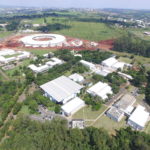Special prices for POCPA participants were negotiated with the hotels below. All the prices are in Brazilian currency (Real – BRL) and a 5% tax must be added. Transfer to/from CNPEM will be provide for the Matiz Barão Geraldo and Vitória Express.
| Single: 241 BRL |
Double: 278 BRL |
Triple: 395 BRL |
Breakfast, parking and internet included.
These prices are available just for reservations made directly with the hotel. It will be necessary present a “POCPA” (venue LNLS|CNPEM) registration receipt and credit card information.
Contact: eventosmatizbaraogeraldo@hotelariabrasil.com.br
+ 55 19 3749 8500
Address: Av. Albino José Barbosa de Oliveira, 1700 • Barão Geraldo • Campinas – SP • 13084-551
Distance from the venue: 5.1 km
Transfer to/from CNPEM will be provide for this hotel.
| Single: 210 BRL |
Double: 240 BRL |
Breakfast and internet included.
It must be mentioned the participation in “POCPA” (venue LNLS|CNPEM) to get these fees.
Contact: vendas.express@vitoriahoteis.com.br
+ 55 19 3708 9500
Address Rua Heitor Ernesto Sartori, 555 Center Santa Genebra | Campinas | SP | 13080-657
Distance from the venue: 10.0 km
Transfer to/from CNPEM will be provide for this hotel.
| Single Superior: 248 BRL |
Double Superior: 286 BRL |
Single Deluxe: 288 BRL |
Double Deluxe: 326 BRL |
Breakfast and internet included. Parking: 20 BRL per day.
It must be mentioned the participation in “POCPA” (venue LNLS|CNPEM) to get these fees.
Contact: reservas.csc@atlanticahotels.com.br
Address: Rua Embiruçu, 300 SP 340 km 116.5 Campinas – SP – CEP: 13098-320
Distance from the venue: 5.1 km
| Single Superior: 223 BRL |
Double Superior: 258 BRL |
Single Deluxe: 261 BRL |
Double Deluxe: 296 BRL |
Breakfast and internet included. Parking: 17 BRL per day.
It must be mentioned the participation in “POCPA” (venue LNLS|CNPEM) to get these fees.
Contact: reservas.sig@atlanticahotels.com.br
Address: Avenida Dr. Carlos Grimaldi, 1653 Campinas – SP – CEP: 13091-000
Distance from the venue: 11.5 km

 The
The